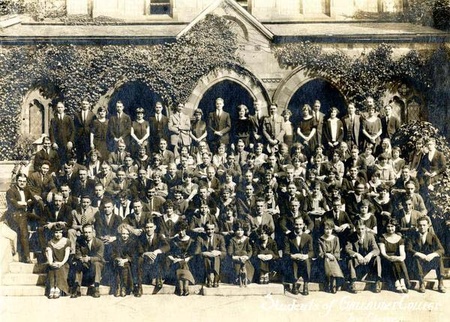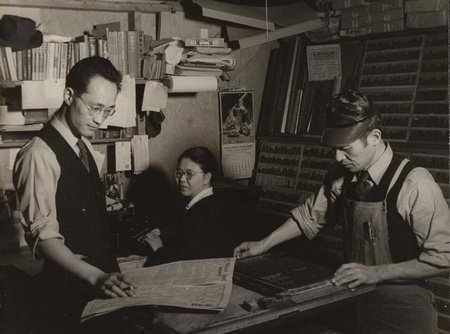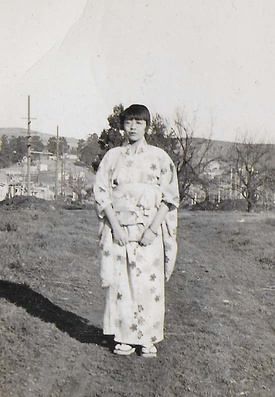In my previous article on Shuji Fujii, I highlighted his work as a writer, editor, and labor activist. Although Fujii ran the radical Japanese community newspaper Doho for most of its existence, he could not have done so without the help of his wife, Kikue. A gifted writer and literary figure, Kikue Ukai Fujii was also one of the first Nisei professional librarians, as well one of the first deaf women of color to attend Gallaudet College and achieve renown.
Kikue Ukai was born on December 10, 1903 in Oakland, California, the eldest daughter of Eiya, a florist, and Tsune Ukai. Kikue experienced hearing loss and loss of vision in one eye following a childhood roller skating accident. The Mill Valley Record, which reported the accident, followed Ukai’s subsequent career. Kikue’s parents enrolled her in the California School for the Deaf and Blind, from which she graduated at the age of 18 in 1921.
From a very young age, Kikue demonstrated her talents as a gifted writer. In 1920, the Nichi Bei Shinbun hosted an essay contest in response to the California state referendum which, if passed, would extend California’s Alien Land Law and further restrict land ownership by Japanese immigrants. Kikue, aged just 16, won second place in the contest with an essay entitled “Why I Want to Become an American Citizen.” Although Kikue was a U.S. citizen by birthright, her essay beautifully spoke to her feeling like an alien in her home country because of the discrimination she faced.

While her powerful skills as a writer fueled her ambition, she also experienced anxieties over success. In July 1922, the Oakland Tribune published a missing person’s report filed by her parents for Kikue, stating that she had disappeared due to “suffering from despondency over failure to obtain certain grades in her school work.”
In 1923, Kikue enrolled at Gallaudet College, a university for the deaf in Washington, D.C. While at Gallaudet, Ukai served as treasurer of the school’s Jollity club. She frequently contributed to Gallaudet’s literary magazine The Buff and Blue, providing a number of essays on women’s fashion and social commentary. In her sophomore year, Ukai published an essay in The Buff and Blue describing her attendance at a Japanese wedding. In addition to describing wedding etiquette and the dress of the geisha girls, she expressed her dissatisfaction with how most of the men, despite being married, flirted with the geishas at the wedding. She likewise lamented that many Japanese and Chinese women did not wear their national dress once in the United States.

Kikue left Gallaudet in 1928 and returned to Oakland, where she entered the school for the Deaf in nearby Berkeley. In 1934, she passed a civil service exam that allowed her to work as a librarian, the first Nisei ever to do so, and thereafter was hired by the Oakland Public Library. In 1936, Ukai began writing a literary column titled “Literary By-Paths” for the English section of the San Francisco newspaper New World Sun, or Shin Sekai Asahi. Many of Ukai’s articles for her column featured commentary on popular books, predominantly texts related to Japanese Americans such as Gustav Eckstein’s biography of scientist Hideo Noguchi. The success of her columns led to their being republished in the Seattle based Japanese American Courier. Kikue published her last column on May 23, 1938.
In addition to her literary column, Kikue occasionally wrote poetry that appeared in the pages of various Japanese American papers. “In the Forest,” her translation of a Japanese poem, appeared in the Nichi Bei Shimbun on March 20, 1939. Additional poems later appeared in the pages of the Los Angeles Rafu Shimpo and Seattle Taihoku Nippo. She became sufficiently known for her writing that in 1939, she was invited to join a newly-formed progressive writers group, the Nisei League of Writers and Artists.
Sometime during the fall of 1939, Kikue became acquainted with Shuji Fujii, a labor organizer and editor of the anti-fascist newspaper Doho. Although Shuji was seven years younger than Kikue, the two began courting. Soon after, Kikue Ukai left her job at the Oakland Public Library to move to Los Angeles, where she married Shuji on March 1, 1940. In the Nichi Bei’s article on the wedding, Kikue was labelled as a “Nisei poetess.”

The Fujiis remained lifelong collaborators, with Kikue often helping Shuji with his writing efforts. Because Shuji spent his youth in Japan and only learned English at a later age, Kikue’s writing skills greatly contributed to the flowering of Doho’s English section. Rafu Shimpo editor Togo Tanaka described Kikue as “a talented writer from Northern California” who wrote “stories, captions, headlines, even...the make-up” for Doho.
Following the bombing of Pearl Harbor in December 1941, Kikue Ukai Fujii worked closely with Shuji as part of the Nisei Writers and Artists Mobilization for Democracy, through which both spouses developed a close friendship with artist Isamu Noguchi. Although a number of surviving letters to Noguchi are addressed from both Shuji and Kikue, their style and level of English prose indicates that Kikue did the actual writing. In her solo letters, Kikue gossiped about various issues within their activist circles, and asked for advice, revealing her deep trust and admiration for him. At times, she encouraged him to get married, suggesting that he date her sisters.
She expressed her fears of a conspiracy organized against her by Shuji’s enemies, and even labelled group members Larry Tajiri, Chiye Mori, and Eddie Shimano as “cowards” and “opportunists” for not sufficiently respecting Shuji. Despite his warm friendship for Shuji, Larry Tajiri noted Kikue’s expressions of hatred towards him in letters criticizing the Pacific Citizen, in which she described him as an ‘opportunist.’ Tajiri himself attributed Kikue’s animosity to him not to political or ideological differences, but to her grudge against him over an article he published during his stint as editor of the Nichi Bei Shimbun describing the suicide of Kikue’s sister, Hana Ukai, in 1935.
In April 1942, Shuji and Kikue Fujii reported to Santa Anita Assembly Center for incarceration. Many of Kikue’s letters to Isamu Noguchi document the early months of camp life, ranging from the summer heat of Los Angeles to the cramped conditions of the racetrack barracks. Following Shuji’s arrest by the FBI on June 22, 1942, Kikue wrote Noguchi pleading for help with his release. Eventually, Shuji secured legal counsel and was released from jail by the judge on July 3, 1942.
Shortly after Shuji’s release from prison, the Fujiis left Santa Anita Assembly Center for New York City, where Shuji began work with the Office of War Information. Kikue maintained her correspondence with Noguchi, with Noguchi promising to visit them in New York after his release from Poston concentration camp.
Very little exists about Kikue’s writings after 1942. Much of her postwar life was spent supporting Shuji and writing letters to various publications. One letter to the New York Times in 1952 addressed the usage of yellow-colored margarine for cooking. In a letter addressed to former Vice President and Presidential candidate Henry Wallace in 1950, shortly after the beginning of the Korean War, Kikue commended Wallace’s stance against Communism. Interestingly, Kikue used her maiden name, stating that her husband objected to her writing to Wallace because of Wallace’s stand toward Communism.
After suffering from a prolonged battle with her health, Kikue Ukai Fujii died in April 1978. In a reminiscence of Shuji and Kikue Fujii, Bill Hosokawa recalled meeting Kikue in the company of Eddie Shimano. Hosokawa described Kikue as “an unusual and remarkable person” who “wrote beautifully and, as I recall, she loved poetry.”
© 2021 Jonathan van Harmelen






